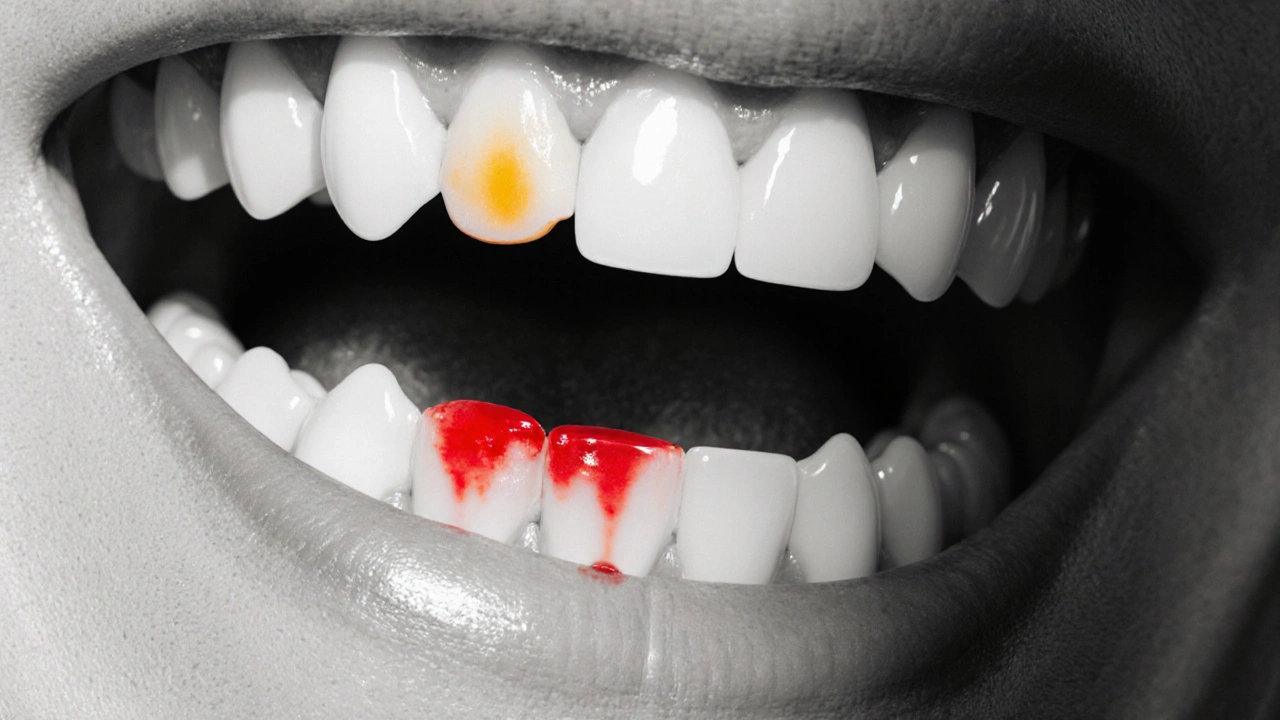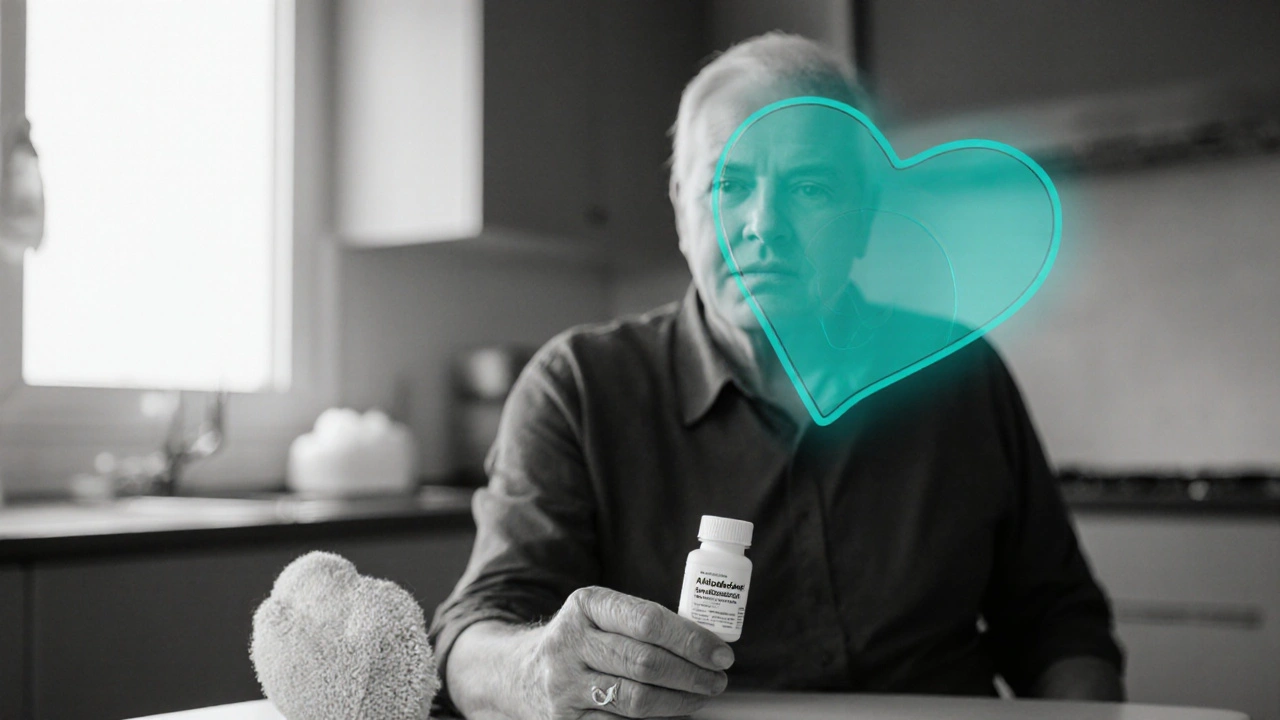Taking amiodarone can keep a shaky heart steady, but it may also throw a wrench into your mouth’s routine. If you’ve been warned about dry mouth, gum bleeding, or unexpected tooth decay, you’re not alone. This guide pulls together the science, real‑world tips, and a quick‑action checklist so you can protect your smile without missing a dose.
What is Amiodarone?
Amiodarone is a class III anti‑arrhythmic medication used to treat serious ventricular and supraventricular rhythm disorders. It was first approved in the 1970s and remains a go‑to for patients who don’t respond to other heart drugs. The medication works by prolonging the heart’s electrical recovery time, which helps prevent dangerous rapid beats.
Why Does Amiodarone Affect Your Mouth?
Although its primary target is the heart, amiodarone circulates throughout the body, reaching salivary glands, gum tissue, and bone. The drug’s high iodine content and its influence on thyroid hormone levels can reduce saliva production, leading to dry mouth (a condition medically termed xerostomia that leaves the oral cavity less protected against decay and infection).
At the same time, amiodarone can thin the blood slightly, making gingival bleeding (easy bleeding of the gums during brushing or flossing) more common. Combined with reduced saliva, the protective enamel layer becomes vulnerable, increasing the risk of tooth decay (cavities caused by acid‑producing bacteria that thrive in a dry mouth environment).
Typical Oral Side Effects of Amiodarone
- Dry mouth (xerostomia) - reduced saliva, bad taste, difficulty chewing.
- Gum bleeding - gums may bleed easily during normal hygiene.
- Gingival overgrowth - sometimes the gums appear puffy or inflamed.
- Altered taste - foods may taste metallic or bland.
- Increased cavity risk - due to less saliva buffering acid.

Practical Steps to Protect Your Teeth
Don’t let side effects dictate your dental future. Here’s a step‑by‑step routine you can adopt right now:
- Hydrate frequently - sip water every 30 minutes, especially after meals.
- Chew sugar‑free gum (xylitol‑based) to stimulate saliva flow.
- Use an alcohol‑free, fluoride‑rich mouthwash twice daily.
- Brush with a soft‑bristled toothbrush and a low‑abrasive, fluoride toothpaste for two minutes.
- Floss gently; if gums bleed, use a floss threader or an interdental brush.
- Schedule a dental check‑up every six months and tell the dentist you’re on amiodarone.
- Ask your dentist about a fluoride varnish or gel to reinforce enamel.
- Consider a saliva substitute spray if dryness feels severe.
Managing Specific Issues
Dry Mouth
Beyond water, try these tricks: keep a humidifier at night, avoid caffeine and alcohol, and opt for soups or smoothies instead of dry snacks. Over‑the‑counter products like Biotène provide both rinses and lozenges that mimic natural saliva.
Gum Bleeding
Gentle brushing is key. Pair it with a pea‑size amount of fluoride (a mineral that strengthens enamel and can reduce inflammation when applied as a varnish) treatment at the dentist. If bleeding persists for more than a week, a short course of a chlorhexidine mouthwash can curb bacterial load.
Tooth Decay
Look for a dental sealant on back molars-this thin protective coating blocks acid‑producing bacteria. Also, ask about resin‑based, high‑fluoride toothpaste (5,000 ppm) for nightly use, but only under professional guidance.
When to Call Your Dentist Immediately
If you notice any of the following, book an urgent appointment:
- Sudden, severe tooth pain that doesn’t ease with over‑the‑counter painkillers.
- Swelling of the gums or a persistent bad breath.
- Loose teeth or noticeable changes in bite alignment.
- Bleeding that lasts longer than a few minutes after brushing.

Talk to Your Cardiologist
Never stop amiodarone without medical advice. However, if oral side effects become unmanageable, discuss the possibility of dose adjustment, alternative anti‑arrhythmic agents, or supplemental thyroid hormone therapy (since amiodarone can induce hypothyroidism, which in turn worsens dry mouth).
Quick Reference Table
| Side Effect | Primary Cause | Top 3 Management Tips |
|---|---|---|
| Dry mouth | Reduced salivary flow from iodine & thyroid changes | Frequent sips of water, sugar‑free gum, saliva substitutes |
| Gum bleeding | Blood‑thinning effect + fragile gums | Soft toothbrush, fluoride varnish, chlorhexidine rinse if needed |
| Tooth decay | Low saliva buffering, increased plaque acidity | Fluoride toothpaste, dental sealants, regular professional cleanings |
| Altered taste | Medication metabolites in saliva | Mint‑flavored rinses, avoid metallic foods, maintain oral hygiene |
Frequently Asked Questions
Can amiodarone cause permanent damage to teeth?
The medication itself does not erase enamel, but the side effects-especially dry mouth-can speed up decay if untreated. With proper oral care and regular dental visits, permanent damage is largely preventable.
Is it safe to take over‑the‑counter fluoride tablets while on amiodarone?
Yes, but only under dental supervision. Excess fluoride can cause fluorosis, so a dentist should set the right dosage based on your oral risk profile.
Should I tell my dentist I’m on amiodarone before any procedure?
Absolutely. Knowing you’re on amiodarone helps the dentist anticipate bleeding tendencies, adjust local anesthetic choices, and plan any necessary antibiotic prophylaxis.
My mouth feels constantly dry-are there prescription options?
Doctors sometimes prescribe pilocarpine or cevimeline, which stimulate salivary glands. Discuss risks and benefits with your cardiologist, as these drugs can affect heart rhythm.
Will stopping amiodarone fix my dental issues?
Stopping the drug may improve saliva flow, but any decay or gum damage already done needs professional treatment. Never discontinue without a cardiology plan.

16 Responses
Oh great another glorified dental pamphlet.
The article presents a comprehensive overview of amiodarone’s oral side effects; however, it would benefit from citing primary literature to substantiate its claims. Additionally, the recommended dosage frequencies for fluoridated products appear overly prescriptive without consideration of individual variance. A more nuanced discussion regarding the interaction between thyroid modulation and salivary flow would enhance the scientific rigor. Overall, the structure is clear, yet the evidentiary support remains insufficient.
Hey folks, love how this guide breaks down the scary stuff into bite‑size tips – it’s like a dental GPS for us on heart meds. The bit about chewing sugar‑free gum really hits home; my sister swears by xylitol to keep her mouth feeling fresh. Remember, hydration isn’t just about water for the heart, it’s also the secret sauce for saliva. If you ever notice your gums bleeding, think of a soft brush as a gentle hug for those delicate tissues. Keep sharing hacks, cuz we’re all in this together!
Considering the interplay between systemic iodine and localized oral dryness invites a broader reflection on how medication reverberates through seemingly unrelated bodily systems. It is not merely a side effect but a reminder that the body operates as a unified ecosystem, each component echoing the others. While the guide offers practical steps, one might also contemplate the ethical responsibility of prescribers to preemptively address such ancillary impacts. Thus, patient education should extend beyond dosage tables to encompass holistic well‑being.
From a cultural standpoint, the emphasis on regular dental visits aligns with preventive health models prevalent in many societies. Incorporating culturally sensitive communication about amiodarone’s oral manifestations can improve patient adherence. It is advisable for clinicians to translate these guidelines into multilingual resources where applicable. Such inclusivity fosters trust and mitigates health disparities.
I totally get how annoying a dry mouth can be – it feels like having a desert in your mouth all day. If you’re ever feeling self‑conscious about the metallic taste, try minty rinses or chew on some fresh herbs; they’re cheap and soothing. Don’t forget to let your dentist know you’re on amiodarone, so they can keep an eye on any gum bleeding. You’re not alone in this, and a little extra care goes a long way!
🦷🔬 The pharmacodynamics of amiodarone extend beyond electrophysiology, permeating salivary gland perfusion with elegant yet pernicious consequences. One must appreciate the intricate balance between anti‑arrhythmic efficacy and mucosal homeostasis. 🧪💧 Implementing a regimented protocol of fluoride varnish and xylitol gum constitutes a sophisticated prophylactic strategy. 🌟
Our healthcare system should prioritize patient education over bureaucratic red tape 🌐💪. Only by empowering individuals can we truly combat the collateral damage of life‑saving drugs 🚀.
Listen up, because the oral fallout from amiodarone is not some trivial anecdote you can brush off with a casual flossing session. First, the drug’s high iodine load sabotages the autonomic regulation of salivary glands, precipitating xerostomia that accelerates enamel demineralization at a rate comparable to untreated diabetes. Second, the mild anticoagulant effect destabilizes gingival capillary integrity, leading to spontaneous hemorrhage upon minimal provocation – a textbook case of iatrogenic coagulopathy manifesting in the oral cavity. Third, the altered taste buds, often described as a metallic or bitter aftertaste, are the result of metabolite deposition in the oral mucosa, a phenomenon documented in several pharmacovigilance reports. Fourth, the cumulative acidogenic environment fostered by reduced salivary buffering capacity creates a perfect storm for Streptococcus mutans proliferation, setting the stage for rampant caries. Fifth, clinicians frequently overlook the synergistic impact of thyroid dysregulation induced by amiodarone, which compounds xerostomia by depressing basal metabolic output of the salivary epithelium. Sixth, the recommended mitigation strategies – such as xylitol gum, fluoride varnish, and saliva substitutes – are not mere adjuncts; they are essential pillars of an integrated therapeutic regimen. Seventh, patient compliance hinges on clear communication; ambiguous instructions lead to suboptimal adherence and eventual dental morbidity. Eighth, dental professionals must calibrate their prophylactic interventions, opting for high‑fluoride dentifrices (5,000 ppm) only under strict supervision to avoid fluorosis. Ninth, regular six‑month recall intervals become non‑negotiable when systemic anti‑arrhythmics are in play, as the window for early lesion detection narrows dramatically. Tenth, interdisciplinary collaboration between cardiology and dentistry is paramount; a coordinated care plan can preempt catastrophic outcomes like tooth loss or systemic infection. Eleventh, emerging research suggests pilocarpine may restore salivary flow, but its cardiac safety profile warrants meticulous risk‑benefit analysis. Twelfth, patients should be educated about the signs of acute periodontal breakdown – spontaneous bleeding, swelling, and severe pain – as red flags for immediate intervention. Thirteenth, lifestyle modifications, including reduced caffeine and alcohol consumption, further ameliorate xerostomic symptoms. Fourteenth, while the drug cannot be discontinued arbitrarily, dosage adjustments or alternative anti‑arrhythmic agents may be explored if oral toxicity becomes unmanageable. Fifteenth, the psychological burden of chronic oral discomfort should not be dismissed; anxiety and depressive symptoms can exacerbate perceived pain. Finally, a holistic approach that integrates pharmacologic insight, diligent oral hygiene, and proactive dental surveillance is the only viable pathway to preserving both cardiac rhythm and dental integrity.
Wow, that was a marathon of info! 🎢 Your breakdown is spot‑on, especially the part about interdisciplinary care – totally the gold standard. Just a heads‑up: “high‑fluoride dentifrices” should be spelled with a hyphen, but you nailed the concept. Keep the jargon coming, it makes the topic feel like a high‑stakes thriller. 🚀
In the grand tapestry of medicine, each prescription threads both cure and collateral, urging us to contemplate the ethical dimensions of side‑effect management. While the guide is pragmatic, a deeper inquiry into patient autonomy could enrich the narrative. Friendly reminder: informed consent isn’t just a signature, it’s an ongoing dialogue.
One wonders whether pharmaceutical companies deliberately suppress comprehensive dental warnings to maximize profit margins.
Philosophically speaking, the mouth is the gateway between inner physiology and external perception, and any disturbance there reverberates through identity itself. Thus, safeguarding oral health while on amiodarone transcends mere comfort; it is an affirmation of self‑respect.
i think staying hydrated and seeing ur dentist regularlly is key.
Great insight! 🌱 Could you share any personal strategies you’ve used to balance the cardiac regimen with daily oral care? Your perspective would be valuable for newcomers.
I’ve found a nightly fluoride rinse works well alongside my meds.